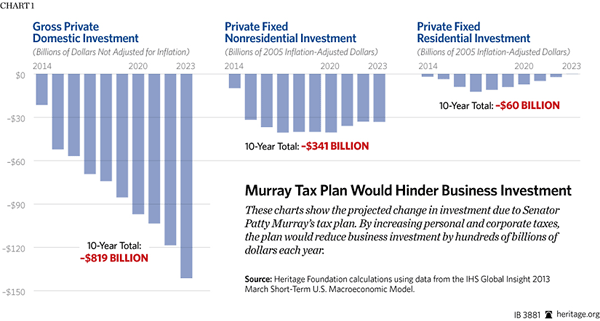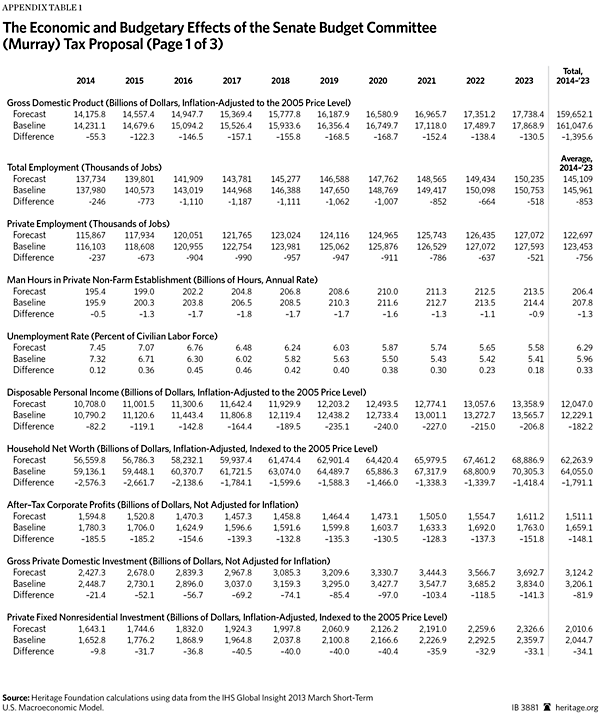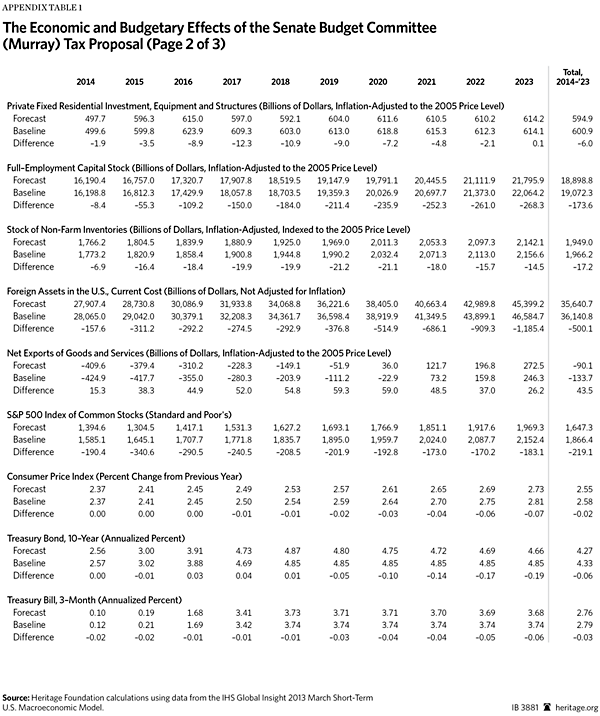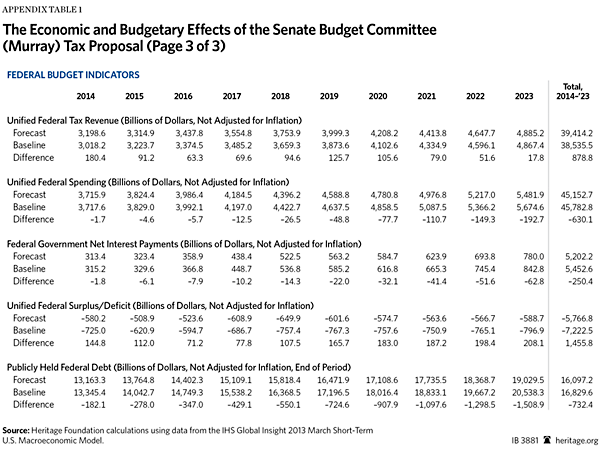Senate Budget Committee chairwoman Patty Murray (D–WA) unveiled the first Senate budget in four years. Murray deserves some credit for actually advancing a budget, but her budget contains steep tax increases that would reduce economic growth by increasing the cost of capital investment.
Murray’s tax plan singles out corporations and individuals that are already faced with high tax rates. While most industrialized nations are moving to reduce their corporate tax rates, Murray plans to increase America’s effective corporate tax rate.
Murray’s Tax Increases
Murray’s budget is clear in that it directly calls for $975 billion in new tax increases over the next decade. However, the budget also contains some techniques for even higher tax increases. It creates special funds to offset new spending and replaces the sequestration spending cuts. Minority Budget Committee staff estimate that the new Senate budget could actually raise taxes by over $1.5 trillion in the next 10 years.[1]
The Senate budget is only a framework document, but it clearly lays out who should pay the higher taxes. The Democratic majority wants higher taxes by “eliminating loopholes and cutting unfair and inefficient spending in the tax code for the wealthiest Americans and biggest corporations.”[2]
Higher corporate tax rates are the exact opposite path taken by most other industrialized countries. The United States has the highest corporate tax rate in the world, and its competitors have been reducing their corporate tax rates. For example, Germany has reduced its top tax rate from 45 percent to 15 percent over the past 13 years. Overall, the European Union has reduced its average corporate tax rate by almost 10 percentage points since 2000.[3] Many economists deem the corporate tax as the most harmful tax to economic growth.[4]
Some of the larger individual income tax expenditure items listed by the Joint Tax Committee are the mortgage interest deduction, tax exclusion of health care benefits, alternate rates for capital gains and dividends, the child tax credit, and the earned income tax credit.[5] The latter two are by definition not earned by “the wealthiest Americans,” because they are phased out as a taxpayer’s income increases. It is therefore likely that Senate Democrats would have to sharply raise the tax rate on capital gains and dividends to generate the needed higher tax revenue specified in their budget.
Attacking Capital, Harming the Economy
The tax increases in the Senate Budget Committee proposal would likely move in the opposite direction of pro-growth tax reform.[6] Senator Murray’s tax proposal raises $1.55 trillion in additional taxes that will likely fall on the “wealth households” and “biggest corporations.”
We estimate the economic and budgetary effects of directing the tax increases toward wealthy households and large Americans by removing some of the tax preferences related to lower rates on capital gains and dividends and to corporations.[7]
Slowdown in Private Business Investment. The Murray tax proposal would slow private business investment substantially over the 10-year forecast period.[8] Increasing taxes on capital and corporate income[9] would slow business investment by $82 billion annually over the 10-year forecast.[10]
The slowdown in business investment and capital in the U.S. economy contributes to a slowdown of $1.4 trillion in real economic output and an average 853,000 U.S. jobs over the 10-year forecast period.
Lower Household Income and Wealth. The burden of these tax increases would not entirely fall on corporate shareholders and wealthy Americans. American households would have less opportunity to grow their income and overall wealth. The tax increases would likely slow the S&P 500 Index of Common Stocks by an average 17 percent from baseline levels over the first five years and an average 14 percent relative to baseline levels over the 10-year period.[11]
Declining asset values and lower income (after-tax personal income would decline an average $180 billion annually) would leave households with an average $1.8 trillion less net wealth annually.
Slower Growth, Less Federal Revenue. The Murray tax proposal would generate less federal revenue as the economy slows. Dynamically, when accounting for the economic feedbacks of the increased taxes on personal and corporate incomes, the Murray proposal would achieve about 57 percent ($878 billion) of the $1.55 trillion static revenue estimate. Over the entire 10-year forecast period Senator Murray’s tax proposal achieves less than the average annual static revenue estimate ($155 billion).
Assuming that the tax increases offsetting higher spending in the Murray budget continue to balance, this means the total deficit reduction in Senator Murray’s budget would be a net $200 billion, substantially less than the $1.85 trillion in deficit saving assumed by Senator Murray’s budget.[12]
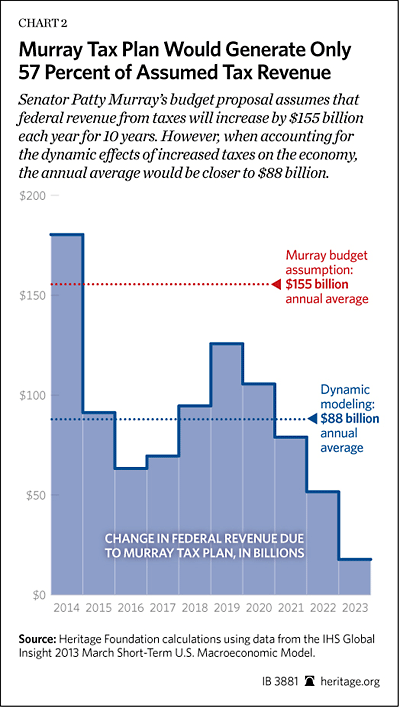
Salt in the Wound
The Senate Budget Committee’s tax hikes would harm economic growth by raising taxes on business and capital investment. Most other countries have chosen to reduce the tax rate on corporations in order to maximize economic growth. The shortsighted budget produced by Senator Murray would result in $1.4 trillion less in total economic output and 853,000 fewer jobs over the 10-year forecast period.
It is bad enough that the Senate Budget Committee has abdicated responsibility on fixing entitlements, but the salt in the wound is the harmful higher taxes that would impact American businesses, individuals, and families.
—Rea S. Hederman Jr. is Director of and Research Fellow in and John L. Ligon is a Senior Policy Analyst in the Center for Data Analysis at The Heritage Foundation.
Appendix A: Methodology
Heritage analysts used the IHS Global Insight 2013 March Short-term U.S. Macroeconomic model. IHS Global Insight is a leading economic forecasting firm in the United States. This model is used by private-sector and government economists to estimate how changes in the economy and public policy are likely to affect major economic indicators. The methodologies, assumptions, conclusions, and opinions presented here are entirely the work of analysts in the Center for Data Analysis at The Heritage Foundation. They have not been endorsed by, and do not necessarily reflect the views of, the owners of the Global Insight model.
The Senate budget argues that “savings” found by eliminating loopholes and inefficient (and unfair) spending in the U.S. federal tax code should not increase the tax burden on middle-class families or the most vulnerable Americans who already have sacrificed greatly in recent deficit-reduction efforts. Therefore, the “savings” should come only from the wealthiest Americans and the biggest corporations.
In this analysis we assume that the static revenue estimate in the Senate budget will fall on tax preferences related to capital gains income, dividend income, and corporate income. We use $1.55 trillion in static revenue.[13] To achieve this amount, we made adjustments to achieve tax rates on capital gains, dividends, and corporate income to raise the $1.55 trillion in revenue.
Moreover, to achieve the $1.55 trillion in static revenue, we increase the rates on these income types by 8 percentage points, equally divided through personal and corporate taxes. On corporate income, we use the handle in the model that measures the difference between the effective and statutory corporate income tax rate—the change in the variable reduces the difference between the statutory and effective rate on corporate income, thereby increasing the effective rate. There was no change imposed on the statutory corporate income tax rate.
Appendix B
